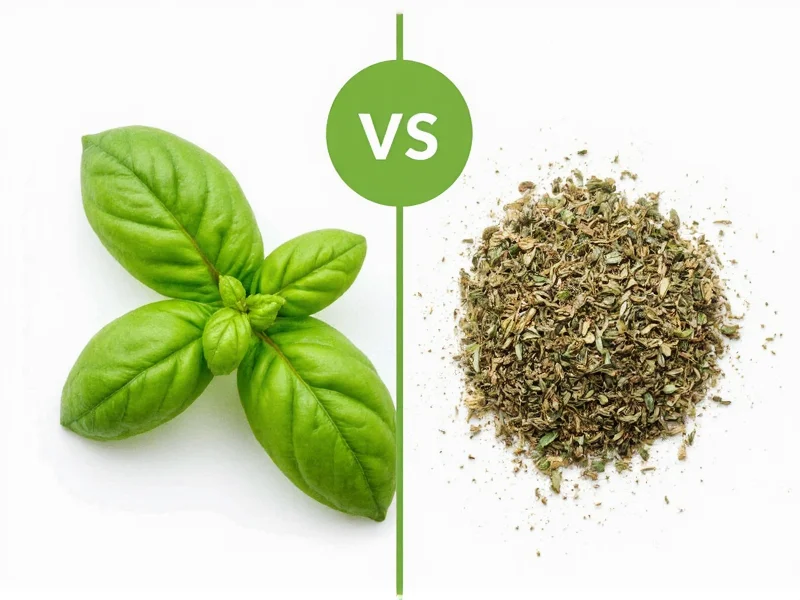Understanding herb conversions is essential for consistent cooking results. When substituting dried basil for fresh in recipes, the standard conversion ratio is critical for maintaining proper flavor balance. This ratio exists because the drying process removes moisture while concentrating the essential oils and flavor compounds in the herb.
The Science Behind Basil Conversion
During the drying process, basil loses approximately 80-90% of its water content. This concentration effect means dried basil delivers more intense flavor in a smaller volume. The essential oils responsible for basil's distinctive aroma and taste become more potent as water evaporates.
Food science research shows that dried herbs generally contain 2-3 times the concentration of volatile compounds compared to their fresh counterparts. This explains why using equal measurements would result in overpowering, sometimes bitter flavors when substituting dried for fresh herbs.
Complete Fresh Basil to Dried Basil Conversion Guide
| Fresh Basil | Dried Basil Equivalent | Best Usage Tip |
|---|---|---|
| 1 teaspoon | ⅓ teaspoon | Add dried early in cooking for soups/stews |
| 1 tablespoon | 1 teaspoon | Standard conversion for most recipes |
| ¼ cup | 1¼ tablespoons | Reduce by 25% for delicate sauces |
| ½ cup | 2½ tablespoons | Consider adding fresh at the end for brightness |
| 1 cup | 5 tablespoons | Best to use fresh for pesto and raw applications |
Flavor Profile Differences Between Fresh and Dried Basil
Fresh basil offers bright, sweet notes with hints of anise and pepper. Its volatile compounds provide immediate aromatic impact but dissipate quickly with heat. Dried basil develops earthier, more muted flavors with subtle camphor notes while losing some of the fresh herb's delicate top notes.
Culinary professionals note that dried basil works best in:
- Long-simmered tomato sauces and soups
- Dry rubs for meats
- Bread doughs and baked savory items
- Herb blends like Italian seasoning
Fresh basil shines in:
- Pesto and raw sauces
- Garnishes for finished dishes
- Cold salads and caprese preparations
- Quick-cooking applications under 10 minutes
Optimal Usage Timing for Best Results
The timing of herb addition significantly impacts flavor development. For dried basil vs fresh basil substitution, consider these professional techniques:
When using dried basil as a fresh basil substitute, add it early in the cooking process—about 20 minutes before completion. This allows time for the dried herb to rehydrate and release its flavor compounds into the dish. Dried herbs need this hydration time to reach their full flavor potential.
With fresh basil, add it during the final 2-3 minutes of cooking or as a garnish. Heat-sensitive compounds in fresh basil degrade quickly, so late addition preserves its vibrant flavor and aroma. This timing difference explains why simply converting measurements isn't always sufficient—you must also adjust when you add the herb.
Storage Guidelines for Maximum Flavor Preservation
Proper storage affects both forms' potency and shelf life. Fresh basil maintains quality for 5-7 days when stored upright in water (like flowers) with a loose plastic bag covering, refrigerated. Never wash basil before storage, as moisture accelerates spoilage.
Dried basil retains optimal flavor for 6-12 months when stored in airtight containers away from light, heat, and moisture. Glass jars in dark pantries outperform plastic containers. Test dried basil's viability by rubbing a small amount between your fingers—if the aroma is weak, it's time for replacement.
Common Substitution Mistakes to Avoid
Many home cooks make these critical errors when substituting dried basil for fresh:
- Using equal measurements - This creates overpowering, sometimes bitter results
- Adding dried herbs too late - They need time to rehydrate and release flavor
- Using old dried herbs - Stale dried basil lacks flavor intensity, leading to overcompensation
- Substituting in raw applications - Dried basil's texture and flavor profile don't work in pesto or salads
Professional chefs recommend tasting as you go when making substitutions. Start with 75% of the converted amount, then adjust after 15 minutes of cooking. Remember that individual dried herb quality varies based on processing methods and storage conditions.
When Fresh Basil Is Truly Irreplaceable
Certain applications simply don't work with dried basil substitutions. These include:
- Traditional pesto (dried basil creates a muddy texture)
- Cold tomato-basil soups like gazpacho
- Caprese salad and similar fresh presentations
- Infused oils and vinegars (dried herbs can promote bacterial growth)
In these cases, consider alternative fresh herbs like parsley or cilantro rather than forcing a dried basil substitution. The texture and fresh aromatic compounds are integral to the dish's success.











 浙公网安备
33010002000092号
浙公网安备
33010002000092号 浙B2-20120091-4
浙B2-20120091-4